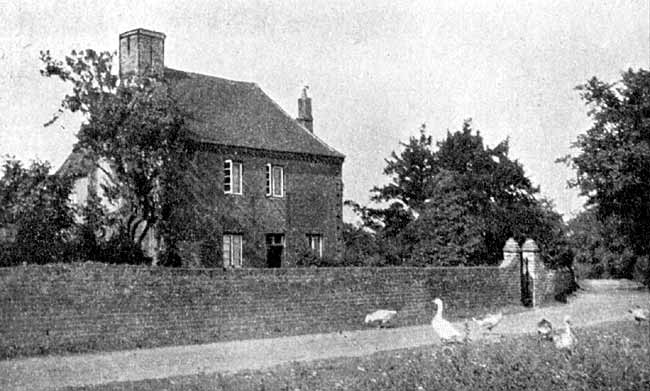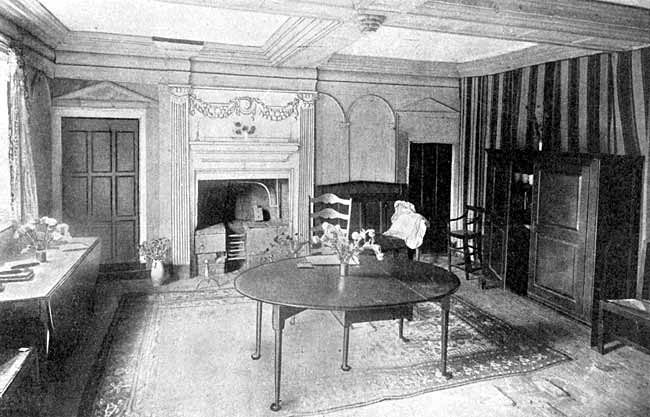Brunsell Hall, Car Colston
By Mr. T. M. Blagg.

Exterior of Brunsell Hall.
This house, or rather what is left of it, is known by the name of Brunsell Hall, and is so marked on the Ordnance Survey maps of the district. It is named from the man who built it, and whose family lived in it, Samuel Brunsell, Doctor of Divinity. About the years 1660 and 1664, Dr. Brunsell bought lands from the Thoroton family, as appears by the title deeds which have been shown to you, and he also bought a messuage and certain lands from William Kirke, which in the time of Richard II. were Robert Chaworth’s, and upon this land, as Thoroton records, “the said Doctor hath built a brick house, being very near Screveton Church, of which he was also Rector.” In the portion which remains of that house we are now standing. The house which occupied this site previously belonged to Richard Kirke, who, being a Roman Catholic, was forced to convey it to his brother William, and died in prison. As there is a legend that treasure is buried in the garden it may be speculated whether Richard may not have hidden his money and plate, and handed over only his real estate.
The Brunsell family came out of Wiltshire, and the Doctor’s brother Henry had married the daughter of Christopher Wren, Dean of Windsor, but I’m afraid we cannot prove that her relative, the great architect, designed the room in which we now are! Dr. Samuel Brunsell was born in 1619, and was a wealthy and powerful dignitary of the church. In 1660 he was Prebendary of Nassington in the Cathedral Church of Lincoln, and in 1664 succeeded his brother Henry Brunsell, who became a Prebendary in the Cathedral of Ely, to the Prebend of Norwell Tertia Pars in the Collegiate Church of Southwell. He had held the incumbency of Bingham during the Commonwealth, but was not formally instituted to that rich rectory until 1662. He became Rector of Screveton also in 1663, but resigned the living in 1671, and was instituted Vicar of Upton, but resigned in 1683. He was appointed Vicar-General to the Chapter of Southwell in 1669. He died in residence at Southwell, 17th January, 1687-8, and was buried in Bingham church two days later. The documents relating to his various appointments I have brought for your inspection, as also the printed copy of a sermon which he preached in Newark church on the day of the happy Restoration of the Monarchy. His son, Henry Brunsell, succeeded him as Rector of Bingham.
Dr. Brunsell, in his capacity as Rector of Bingham, is said to have been one of the last men to officially “lay” a ghost. The said ghost frequented Chapel Lane, at Bingham, and much annoyed and perturbed the good folk of the town. One cause why ghosts “walk” is supposed to be this,—that the material body has not received Christian burial. A grave was accordingly dug in Bingham churchyard and a coffin prepared. Whether the coffin, with the lid invitingly open was left overnight in Chapel Lane, or whether by cunning incantations the graveless sprite was coaxed to enter it, I do not know; or whether in the morning or at the dread hour of midnight the ghostly cortege moved; but this has been told to me by an old man whose grandmother heard it from her grandmother (all Bingham folk), that Dr. Brunsell, majestic in wig and gown, with the populace in procession, escorted that coffin, borne on bier shoulder high, from Chapel Lane to the churchyard, where the solemn burial service was read and the coffin lowered into the grave. Thenceforth that restless spirit troubled no more the good people of Bingham, as he who doubts my story may prove, by keeping vigil by himself in Chapel Lane, any night he likes!

Interior of Brunsell Hall.
The members of the Brunsell family who continued to reside at Car-Colston led very scandalous lives and came to a bad end, and the property passed into the possession of my own ancestors, the Sampeys, in 1759.”
